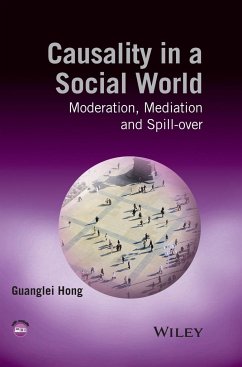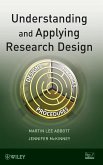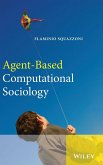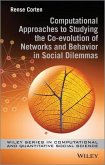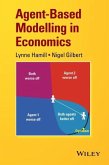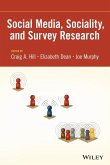- Gebundenes Buch
- Merkliste
- Auf die Merkliste
- Bewerten Bewerten
- Teilen
- Produkt teilen
- Produkterinnerung
- Produkterinnerung
Causality in a Social World introduces innovative new statistical research and strategies for investigating moderated intervention effects, mediated intervention effects, and spill-over effects using experimental or quasi-experimental data.
The book uses potential outcomes to define causal effects, explains and evaluates identification assumptions using application examples, and compares innovative statistical strategies with conventional analysis methods. Whilst highlighting the crucial role of good research design and the evaluation of assumptions required for identifying causal effects…mehr
Andere Kunden interessierten sich auch für
![Understanding and Applying Research Design Understanding and Applying Research Design]() Martin Lee AbbottUnderstanding and Applying Research Design149,99 €
Martin Lee AbbottUnderstanding and Applying Research Design149,99 €![Agent-Based Computational Sociology Agent-Based Computational Sociology]() Flaminio SquazzoniAgent-Based Computational Sociology92,99 €
Flaminio SquazzoniAgent-Based Computational Sociology92,99 €![Computational Approaches to Studying the Co-Evolution of Networks and Behavior in Social Dilemmas Computational Approaches to Studying the Co-Evolution of Networks and Behavior in Social Dilemmas]() Rense CortenComputational Approaches to Studying the Co-Evolution of Networks and Behavior in Social Dilemmas89,99 €
Rense CortenComputational Approaches to Studying the Co-Evolution of Networks and Behavior in Social Dilemmas89,99 €![Agent-Based Modelling in Economics Agent-Based Modelling in Economics]() Lynne HamillAgent-Based Modelling in Economics76,99 €
Lynne HamillAgent-Based Modelling in Economics76,99 €![Analytical Sociology Analytical Sociology]() Analytical Sociology115,99 €
Analytical Sociology115,99 €![Social Media, Sociality, and Survey Research Social Media, Sociality, and Survey Research]() Craig A. HillSocial Media, Sociality, and Survey Research89,99 €
Craig A. HillSocial Media, Sociality, and Survey Research89,99 €![Behavioral Computational Social Science Behavioral Computational Social Science]() Riccardo BoeroBehavioral Computational Social Science88,99 €
Riccardo BoeroBehavioral Computational Social Science88,99 €-
-
-
Causality in a Social World introduces innovative new statistical research and strategies for investigating moderated intervention effects, mediated intervention effects, and spill-over effects using experimental or quasi-experimental data.
The book uses potential outcomes to define causal effects, explains and evaluates identification assumptions using application examples, and compares innovative statistical strategies with conventional analysis methods. Whilst highlighting the crucial role of good research design and the evaluation of assumptions required for identifying causal effects in the context of each application, the author demonstrates that improved statistical procedures will greatly enhance the empirical study of causal relationship theory.
Applications focus on interventions designed to improve outcomes for participants who are embedded in social settings, including families, classrooms, schools, neighbourhoods, and workplaces.
Hinweis: Dieser Artikel kann nur an eine deutsche Lieferadresse ausgeliefert werden.
The book uses potential outcomes to define causal effects, explains and evaluates identification assumptions using application examples, and compares innovative statistical strategies with conventional analysis methods. Whilst highlighting the crucial role of good research design and the evaluation of assumptions required for identifying causal effects in the context of each application, the author demonstrates that improved statistical procedures will greatly enhance the empirical study of causal relationship theory.
Applications focus on interventions designed to improve outcomes for participants who are embedded in social settings, including families, classrooms, schools, neighbourhoods, and workplaces.
Hinweis: Dieser Artikel kann nur an eine deutsche Lieferadresse ausgeliefert werden.
Produktdetails
- Produktdetails
- Verlag: Wiley & Sons
- 1. Auflage
- Seitenzahl: 448
- Erscheinungstermin: 17. August 2015
- Englisch
- Abmessung: 250mm x 175mm x 28mm
- Gewicht: 942g
- ISBN-13: 9781118332566
- ISBN-10: 1118332563
- Artikelnr.: 41771643
- Herstellerkennzeichnung
- Libri GmbH
- Europaallee 1
- 36244 Bad Hersfeld
- gpsr@libri.de
- Verlag: Wiley & Sons
- 1. Auflage
- Seitenzahl: 448
- Erscheinungstermin: 17. August 2015
- Englisch
- Abmessung: 250mm x 175mm x 28mm
- Gewicht: 942g
- ISBN-13: 9781118332566
- ISBN-10: 1118332563
- Artikelnr.: 41771643
- Herstellerkennzeichnung
- Libri GmbH
- Europaallee 1
- 36244 Bad Hersfeld
- gpsr@libri.de
Guanglei Hong, University of Chicago, Department of Comparative Human Development, USA.
Preface xv
Part I Overview 1
1 Introduction 3
1.1 Concepts of moderation, mediation, and spill-over 3
1.2 Weighting methods for causal inference 10
1.3 Objectives and organization of the book 11
1.4 How is this book situated among other publications on related topics?
12
2 Review of causal inference concepts and methods 18
2.1 Causal inference theory 18
2.2 Applications to Lord's paradox and Simpson's paradox 27
2.3 Identification and estimation 34
3 Review of causal inference designs and analytic methods 40
3.1 Experimental designs 40
3.2 Quasiexperimental designs 44
3.3 Statistical adjustment methods 46
3.4 Propensity score 55
4 Adjustment for selection bias through weighting 76
4.1 Weighted estimation of population parameters in survey sampling 77
4.2 Weighting adjustment for selection bias in causal inference 80
4.3 MMWS 86
5 Evaluations of multivalued treatments 100
5.1 Defining the causal effects of multivalued treatments 100
5.2 Existing designs and analytic methods for evaluating multivalued
treatments 102
5.3 MMWS for evaluating multivalued treatments 112
5.4 Summary 123
Part II Moderation 127
6 Moderated treatment effects: concepts and existing analytic methods 129
6.1 What is moderation? 129
6.2 Experimental designs and analytic methods for investigating explicit
moderators 136
6.3 Existing research designs and analytic methods for investigating
implicit moderators 142
7 Marginal mean weighting through stratification for investigating
moderated treatment effects 159
7.1 Existing methods for moderation analyses with quasiexperimental data
159
7.2 MMWS estimation of treatment effects moderated by individual or
contextual characteristics 168
7.3 MMWS estimation of the joint effects of concurrent treatments 174
8 Cumulative effects of time-varying treatments 185
8.1 Causal effects of treatment sequences 186
8.2 Existing strategies for evaluating time-varying treatments 190
8.3 MMWS for evaluating 2-year treatment sequences 195
8.4 MMWS for evaluating multiyear sequences of multivalued treatments 204
8.5 Conclusion 207
Part III Mediation 211
9 Concepts of mediated treatment effects and experimental designs for
investigating causal mechanisms 213
9.1 Introduction 214
9.2 Path coefficients 215
9.3 Potential outcomes and potential mediators 216
9.4 Causal effects with counterfactual mediators 219
9.5 Population causal parameters 222
9.6 Experimental designs for studying causal mediation 225
10 Existing analytic methods for investigating causal mediation mechanisms
238
10.1 Path analysis and SEM 239
10.2 Modified regression approach 246
10.3 Marginal structural models 250
10.4 Conditional structural models 252
10.5 Alternative weighting methods 254
10.6 Resampling approach 256
10.7 IV method 257
10.8 Principal stratification 259
10.9 Sensitivity analysis 261
10.10 Conclusion 265
11 Investigations of a simple mediation mechanism 273
11.1 Application example: national evaluation of welfare-to-work strategies
274
11.2 RMPW rationale 277
11.3 Parametric RMPW procedure 287
11.4 Nonparametric RMPW procedure 290
11.5 Simulation results 292
11.6 Discussion 295
12 RMPW extensions to alternative designs and measurement 301
12.1 RMPW extensions to mediators and outcomes of alternative distributions
301
12.2 RMPW extensions to alternative research designs 306
12.3 Alternative decomposition of the treatment effect 321
13 RMPW extensions to studies of complex mediation mechanisms 325
13.1 RMPW extensions to moderated mediation 325
13.2 RMPW extensions to concurrent mediators 328
13.3 RMPW extensions to consecutive mediators 340
13.4 Discussion 355
Part IV Spill-over 363
14 Spill-over of treatment effects: concepts and methods 365
14.1 Spill-over: A nuisance, a trifle, or a focus? 365
14.2 Stable versus unstable potential outcome values: An example from
agriculture 367
14.3 Consequences for causal inference when spill-over is overlooked 369
14.4 Modified framework of causal inference 371
14.5 Identification: Challenges and solutions 376
14.6 Analytic strategies for experimental and quasiexperimental data 384
14.7 Summary 387
15 Mediation through spill-over 391
15.1 Definition of mediated effects through spill-over in a cluster
randomized trial 393
15.2 Identification and estimation of the spill-over effect in a cluster
randomized design 395
15.3 Definition of mediated effects through spill-over in a multisite trial
402
15.4 Identification and estimation of spill-over effects in a multisite
trial 406
15.5 Consequences of omitting spill-over effects in causal mediation
analyses 412
15.6 Quasiexperimental application 416
15.7 Summary 419
Index 423
Part I Overview 1
1 Introduction 3
1.1 Concepts of moderation, mediation, and spill-over 3
1.2 Weighting methods for causal inference 10
1.3 Objectives and organization of the book 11
1.4 How is this book situated among other publications on related topics?
12
2 Review of causal inference concepts and methods 18
2.1 Causal inference theory 18
2.2 Applications to Lord's paradox and Simpson's paradox 27
2.3 Identification and estimation 34
3 Review of causal inference designs and analytic methods 40
3.1 Experimental designs 40
3.2 Quasiexperimental designs 44
3.3 Statistical adjustment methods 46
3.4 Propensity score 55
4 Adjustment for selection bias through weighting 76
4.1 Weighted estimation of population parameters in survey sampling 77
4.2 Weighting adjustment for selection bias in causal inference 80
4.3 MMWS 86
5 Evaluations of multivalued treatments 100
5.1 Defining the causal effects of multivalued treatments 100
5.2 Existing designs and analytic methods for evaluating multivalued
treatments 102
5.3 MMWS for evaluating multivalued treatments 112
5.4 Summary 123
Part II Moderation 127
6 Moderated treatment effects: concepts and existing analytic methods 129
6.1 What is moderation? 129
6.2 Experimental designs and analytic methods for investigating explicit
moderators 136
6.3 Existing research designs and analytic methods for investigating
implicit moderators 142
7 Marginal mean weighting through stratification for investigating
moderated treatment effects 159
7.1 Existing methods for moderation analyses with quasiexperimental data
159
7.2 MMWS estimation of treatment effects moderated by individual or
contextual characteristics 168
7.3 MMWS estimation of the joint effects of concurrent treatments 174
8 Cumulative effects of time-varying treatments 185
8.1 Causal effects of treatment sequences 186
8.2 Existing strategies for evaluating time-varying treatments 190
8.3 MMWS for evaluating 2-year treatment sequences 195
8.4 MMWS for evaluating multiyear sequences of multivalued treatments 204
8.5 Conclusion 207
Part III Mediation 211
9 Concepts of mediated treatment effects and experimental designs for
investigating causal mechanisms 213
9.1 Introduction 214
9.2 Path coefficients 215
9.3 Potential outcomes and potential mediators 216
9.4 Causal effects with counterfactual mediators 219
9.5 Population causal parameters 222
9.6 Experimental designs for studying causal mediation 225
10 Existing analytic methods for investigating causal mediation mechanisms
238
10.1 Path analysis and SEM 239
10.2 Modified regression approach 246
10.3 Marginal structural models 250
10.4 Conditional structural models 252
10.5 Alternative weighting methods 254
10.6 Resampling approach 256
10.7 IV method 257
10.8 Principal stratification 259
10.9 Sensitivity analysis 261
10.10 Conclusion 265
11 Investigations of a simple mediation mechanism 273
11.1 Application example: national evaluation of welfare-to-work strategies
274
11.2 RMPW rationale 277
11.3 Parametric RMPW procedure 287
11.4 Nonparametric RMPW procedure 290
11.5 Simulation results 292
11.6 Discussion 295
12 RMPW extensions to alternative designs and measurement 301
12.1 RMPW extensions to mediators and outcomes of alternative distributions
301
12.2 RMPW extensions to alternative research designs 306
12.3 Alternative decomposition of the treatment effect 321
13 RMPW extensions to studies of complex mediation mechanisms 325
13.1 RMPW extensions to moderated mediation 325
13.2 RMPW extensions to concurrent mediators 328
13.3 RMPW extensions to consecutive mediators 340
13.4 Discussion 355
Part IV Spill-over 363
14 Spill-over of treatment effects: concepts and methods 365
14.1 Spill-over: A nuisance, a trifle, or a focus? 365
14.2 Stable versus unstable potential outcome values: An example from
agriculture 367
14.3 Consequences for causal inference when spill-over is overlooked 369
14.4 Modified framework of causal inference 371
14.5 Identification: Challenges and solutions 376
14.6 Analytic strategies for experimental and quasiexperimental data 384
14.7 Summary 387
15 Mediation through spill-over 391
15.1 Definition of mediated effects through spill-over in a cluster
randomized trial 393
15.2 Identification and estimation of the spill-over effect in a cluster
randomized design 395
15.3 Definition of mediated effects through spill-over in a multisite trial
402
15.4 Identification and estimation of spill-over effects in a multisite
trial 406
15.5 Consequences of omitting spill-over effects in causal mediation
analyses 412
15.6 Quasiexperimental application 416
15.7 Summary 419
Index 423
Preface xv
Part I Overview 1
1 Introduction 3
1.1 Concepts of moderation, mediation, and spill-over 3
1.2 Weighting methods for causal inference 10
1.3 Objectives and organization of the book 11
1.4 How is this book situated among other publications on related topics?
12
2 Review of causal inference concepts and methods 18
2.1 Causal inference theory 18
2.2 Applications to Lord's paradox and Simpson's paradox 27
2.3 Identification and estimation 34
3 Review of causal inference designs and analytic methods 40
3.1 Experimental designs 40
3.2 Quasiexperimental designs 44
3.3 Statistical adjustment methods 46
3.4 Propensity score 55
4 Adjustment for selection bias through weighting 76
4.1 Weighted estimation of population parameters in survey sampling 77
4.2 Weighting adjustment for selection bias in causal inference 80
4.3 MMWS 86
5 Evaluations of multivalued treatments 100
5.1 Defining the causal effects of multivalued treatments 100
5.2 Existing designs and analytic methods for evaluating multivalued
treatments 102
5.3 MMWS for evaluating multivalued treatments 112
5.4 Summary 123
Part II Moderation 127
6 Moderated treatment effects: concepts and existing analytic methods 129
6.1 What is moderation? 129
6.2 Experimental designs and analytic methods for investigating explicit
moderators 136
6.3 Existing research designs and analytic methods for investigating
implicit moderators 142
7 Marginal mean weighting through stratification for investigating
moderated treatment effects 159
7.1 Existing methods for moderation analyses with quasiexperimental data
159
7.2 MMWS estimation of treatment effects moderated by individual or
contextual characteristics 168
7.3 MMWS estimation of the joint effects of concurrent treatments 174
8 Cumulative effects of time-varying treatments 185
8.1 Causal effects of treatment sequences 186
8.2 Existing strategies for evaluating time-varying treatments 190
8.3 MMWS for evaluating 2-year treatment sequences 195
8.4 MMWS for evaluating multiyear sequences of multivalued treatments 204
8.5 Conclusion 207
Part III Mediation 211
9 Concepts of mediated treatment effects and experimental designs for
investigating causal mechanisms 213
9.1 Introduction 214
9.2 Path coefficients 215
9.3 Potential outcomes and potential mediators 216
9.4 Causal effects with counterfactual mediators 219
9.5 Population causal parameters 222
9.6 Experimental designs for studying causal mediation 225
10 Existing analytic methods for investigating causal mediation mechanisms
238
10.1 Path analysis and SEM 239
10.2 Modified regression approach 246
10.3 Marginal structural models 250
10.4 Conditional structural models 252
10.5 Alternative weighting methods 254
10.6 Resampling approach 256
10.7 IV method 257
10.8 Principal stratification 259
10.9 Sensitivity analysis 261
10.10 Conclusion 265
11 Investigations of a simple mediation mechanism 273
11.1 Application example: national evaluation of welfare-to-work strategies
274
11.2 RMPW rationale 277
11.3 Parametric RMPW procedure 287
11.4 Nonparametric RMPW procedure 290
11.5 Simulation results 292
11.6 Discussion 295
12 RMPW extensions to alternative designs and measurement 301
12.1 RMPW extensions to mediators and outcomes of alternative distributions
301
12.2 RMPW extensions to alternative research designs 306
12.3 Alternative decomposition of the treatment effect 321
13 RMPW extensions to studies of complex mediation mechanisms 325
13.1 RMPW extensions to moderated mediation 325
13.2 RMPW extensions to concurrent mediators 328
13.3 RMPW extensions to consecutive mediators 340
13.4 Discussion 355
Part IV Spill-over 363
14 Spill-over of treatment effects: concepts and methods 365
14.1 Spill-over: A nuisance, a trifle, or a focus? 365
14.2 Stable versus unstable potential outcome values: An example from
agriculture 367
14.3 Consequences for causal inference when spill-over is overlooked 369
14.4 Modified framework of causal inference 371
14.5 Identification: Challenges and solutions 376
14.6 Analytic strategies for experimental and quasiexperimental data 384
14.7 Summary 387
15 Mediation through spill-over 391
15.1 Definition of mediated effects through spill-over in a cluster
randomized trial 393
15.2 Identification and estimation of the spill-over effect in a cluster
randomized design 395
15.3 Definition of mediated effects through spill-over in a multisite trial
402
15.4 Identification and estimation of spill-over effects in a multisite
trial 406
15.5 Consequences of omitting spill-over effects in causal mediation
analyses 412
15.6 Quasiexperimental application 416
15.7 Summary 419
Index 423
Part I Overview 1
1 Introduction 3
1.1 Concepts of moderation, mediation, and spill-over 3
1.2 Weighting methods for causal inference 10
1.3 Objectives and organization of the book 11
1.4 How is this book situated among other publications on related topics?
12
2 Review of causal inference concepts and methods 18
2.1 Causal inference theory 18
2.2 Applications to Lord's paradox and Simpson's paradox 27
2.3 Identification and estimation 34
3 Review of causal inference designs and analytic methods 40
3.1 Experimental designs 40
3.2 Quasiexperimental designs 44
3.3 Statistical adjustment methods 46
3.4 Propensity score 55
4 Adjustment for selection bias through weighting 76
4.1 Weighted estimation of population parameters in survey sampling 77
4.2 Weighting adjustment for selection bias in causal inference 80
4.3 MMWS 86
5 Evaluations of multivalued treatments 100
5.1 Defining the causal effects of multivalued treatments 100
5.2 Existing designs and analytic methods for evaluating multivalued
treatments 102
5.3 MMWS for evaluating multivalued treatments 112
5.4 Summary 123
Part II Moderation 127
6 Moderated treatment effects: concepts and existing analytic methods 129
6.1 What is moderation? 129
6.2 Experimental designs and analytic methods for investigating explicit
moderators 136
6.3 Existing research designs and analytic methods for investigating
implicit moderators 142
7 Marginal mean weighting through stratification for investigating
moderated treatment effects 159
7.1 Existing methods for moderation analyses with quasiexperimental data
159
7.2 MMWS estimation of treatment effects moderated by individual or
contextual characteristics 168
7.3 MMWS estimation of the joint effects of concurrent treatments 174
8 Cumulative effects of time-varying treatments 185
8.1 Causal effects of treatment sequences 186
8.2 Existing strategies for evaluating time-varying treatments 190
8.3 MMWS for evaluating 2-year treatment sequences 195
8.4 MMWS for evaluating multiyear sequences of multivalued treatments 204
8.5 Conclusion 207
Part III Mediation 211
9 Concepts of mediated treatment effects and experimental designs for
investigating causal mechanisms 213
9.1 Introduction 214
9.2 Path coefficients 215
9.3 Potential outcomes and potential mediators 216
9.4 Causal effects with counterfactual mediators 219
9.5 Population causal parameters 222
9.6 Experimental designs for studying causal mediation 225
10 Existing analytic methods for investigating causal mediation mechanisms
238
10.1 Path analysis and SEM 239
10.2 Modified regression approach 246
10.3 Marginal structural models 250
10.4 Conditional structural models 252
10.5 Alternative weighting methods 254
10.6 Resampling approach 256
10.7 IV method 257
10.8 Principal stratification 259
10.9 Sensitivity analysis 261
10.10 Conclusion 265
11 Investigations of a simple mediation mechanism 273
11.1 Application example: national evaluation of welfare-to-work strategies
274
11.2 RMPW rationale 277
11.3 Parametric RMPW procedure 287
11.4 Nonparametric RMPW procedure 290
11.5 Simulation results 292
11.6 Discussion 295
12 RMPW extensions to alternative designs and measurement 301
12.1 RMPW extensions to mediators and outcomes of alternative distributions
301
12.2 RMPW extensions to alternative research designs 306
12.3 Alternative decomposition of the treatment effect 321
13 RMPW extensions to studies of complex mediation mechanisms 325
13.1 RMPW extensions to moderated mediation 325
13.2 RMPW extensions to concurrent mediators 328
13.3 RMPW extensions to consecutive mediators 340
13.4 Discussion 355
Part IV Spill-over 363
14 Spill-over of treatment effects: concepts and methods 365
14.1 Spill-over: A nuisance, a trifle, or a focus? 365
14.2 Stable versus unstable potential outcome values: An example from
agriculture 367
14.3 Consequences for causal inference when spill-over is overlooked 369
14.4 Modified framework of causal inference 371
14.5 Identification: Challenges and solutions 376
14.6 Analytic strategies for experimental and quasiexperimental data 384
14.7 Summary 387
15 Mediation through spill-over 391
15.1 Definition of mediated effects through spill-over in a cluster
randomized trial 393
15.2 Identification and estimation of the spill-over effect in a cluster
randomized design 395
15.3 Definition of mediated effects through spill-over in a multisite trial
402
15.4 Identification and estimation of spill-over effects in a multisite
trial 406
15.5 Consequences of omitting spill-over effects in causal mediation
analyses 412
15.6 Quasiexperimental application 416
15.7 Summary 419
Index 423

